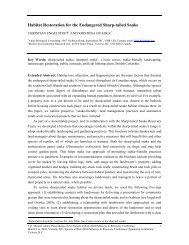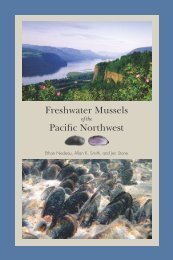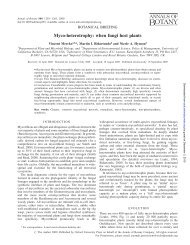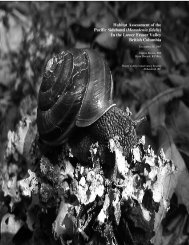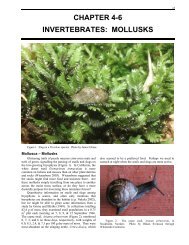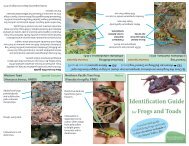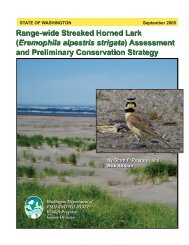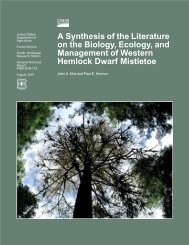Coastal Cutthroat Trout as Sentinels of Lower Mainland Watershed ...
Coastal Cutthroat Trout as Sentinels of Lower Mainland Watershed ...
Coastal Cutthroat Trout as Sentinels of Lower Mainland Watershed ...
Create successful ePaper yourself
Turn your PDF publications into a flip-book with our unique Google optimized e-Paper software.
66because piscivorous Taylor Lake cutthroat likely use small rainbow <strong>as</strong> a food source,providing an opportunity for trophy-sized cutthroat in the catch. Consideration should begiven to maximum size regulations on cutthroat in these rainbow-cutthroat lakes thatwould encourage the development <strong>of</strong> large piscivorous cutthroat, thus making these lakefisheries more attractive to anglers. Hybridization <strong>of</strong> rainbow with cutthroat trout inthese lakes can have genetic consequences from a loss <strong>of</strong> fitness <strong>of</strong> native cutthroat, andthus further rainbow trout stocking <strong>of</strong> native cutthroat lakes should be largely avoided (E.Parkinson, pers. comm. 2004).A concern raised by Lister (1999) at Hicks, Deer and Weaver Lakes, and noted byGeorge (1983) from a natural recruitment study at Rolley Lake, is that stocking targetsmay not account sufficiently for natural production from inlet and outlet streams. Giventhe cost <strong>of</strong> hatchery trout ranging in mean size <strong>of</strong> 20-40 g, Lister suggests this practicew<strong>as</strong> inefficient because percent harvest <strong>of</strong> stocked rainbow trout w<strong>as</strong> estimated to besmall (only 1 to 15 % and 9 to 22 % at Deer and Weaver Lakes, respectively). Naturalproduction w<strong>as</strong> evidently significant and at that time unaccounted for in an applied lakestocking formula. Since then stocking <strong>of</strong> rainbow h<strong>as</strong> been eliminated at Deer Lake, andstocking <strong>of</strong> cutthroat trout have been reduced by 60 % from 9,000 to 3,500 annually.Similar re-examinations <strong>of</strong> other cutthroat-rainbow lakes (e.g., Rolley Lake) to accountfor natural production is advisable where possible.Generally the cl<strong>as</strong>sification <strong>of</strong> the Sunshine Co<strong>as</strong>t lakes (particularly the chains <strong>of</strong> PowellRiver lakes) <strong>as</strong> wild cutthroat lakes is a sound management decision that only requiresmore innovative use <strong>of</strong> regulations plus some selective investments in stream restoration.Sufficient age 1-3 parr recruits from inlet and outlet nursery streams are required tosupport premier wild cutthroat lake fisheries over the long-term. Thus, stream habitatrestoration should be a high priority for those wild cutthroat lakes with greater thanaverage natural productivity and high recreational demand.6. LOWER MAINLAND REGION CUTTHROAT TROUT FISHERIESThe largest river fishery in the <strong>Lower</strong> <strong>Mainland</strong> Region takes place in the lower Fr<strong>as</strong>erRiver, consisting primarily <strong>of</strong> a multi-species “bar fisheries” during the salmon se<strong>as</strong>on.80 % <strong>of</strong> participants in these “bar fisheries” have reported that they are angling forsalmon, trout and char (Schubert 1992). In addition, the “cutthroat se<strong>as</strong>on” extendsthroughout the winter. River fisheries are documented on all <strong>Lower</strong> <strong>Mainland</strong> riversalong the co<strong>as</strong>t and including the lower Fr<strong>as</strong>er River, particularly the Harrison-Chehalis,Alouette, Stave, Vedder Canal and Nicomekl-Little Campbell. The smaller sloughfisheries target some <strong>of</strong> the same Fr<strong>as</strong>er stocks and include: Nicomen; Maria; Mountain;Wahleach; and other sloughs. The estuary and beach fisheries are largely directed at theSunshine Co<strong>as</strong>t and Crescent Beach-White Rock, with small fisheries along Howe Soundand the Powell River co<strong>as</strong>tlines, many <strong>of</strong> which are guarded secrets (J. Roberts, pers.comm. 2004). The river fisheries on migratory lake stocks are the le<strong>as</strong>t understood butexamples are Harrison and Pitt systems. In the Harrison River watershed, cutthroat likelymigrate into Harrison River, Big Silver Creek and Lillooet River to feed on dislodgedsalmon eggs and carc<strong>as</strong>ses in the autumn and emergent/migrating fry in the spring.



